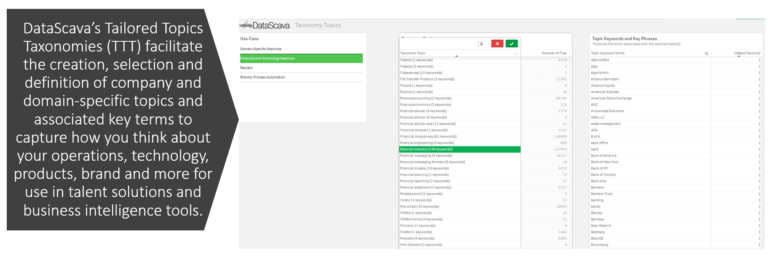TalentBrowser is powered by DataScava
Automated Skills Analytics, Domain-Specific Search, and Talent Matching
Powered by DataScava’s domain-specific unstructured data miner, TalentBrowser gets the most from the raw text on profiles, resumes, job descriptions, and more, working alone or with your existing solutions.
It pinpoints, measures, and matches the skills, experience, and roles of your in-house talent, job applicants, and previously-sourced candidates in real-time automatically 24/7, keeping the Human in Command.
Use the value-added weighted topic scores and other metadata our tools generate in your People Analytics, Talent Matching, Talent Acquisition, Workforce Planning, Resource Management, and other HCM initiatives.
Go to TalentBrowser Website to Learn More
How It Works
Automated Skills Analytics
Automated Skills Analytics algorithms generate millions of Weighted Topic Scores and other value-added visible metadata from your resumes and profiles — about each person’s skills, roles, experience, education, and more — to unlock the value of incoming applicants, previously-sourced candidates, and your existing staff.
Domain-Specific Search
TalentBrowser uses DataScava’s Domain-Specific Language Processing (DSLP), which works as an adjunct or alternative to Natural Language Processing (NLP), and Tailored Topics Taxonomies, which lets you select, edit, create, weight, and refine your topics of interest in real-time for use in mining your resumes and profiles.
Patented Weighted Matching
TalentBrowser uses DataScava’s Domain-Specific Language Processing (DSLP), which works as an adjunct or alternative to Natural Language Processing (NLP), and Tailored Topics Taxonomies, which lets you select, edit, create, weight, and refine your topics of interest in real-time for use in mining your resumes and profiles.
Applicant Tracking System
TalentBrowser’s standalone Application Tracking System with Automated Skills Analytics, Domain-Specific Search, and Talent Matching can integrate seamlessly with your existing talent solutions and business intelligence tools.
Our Approach
Taxonomies for Financial and IT Domains
Tailored Topics Taxonomies (TTS)
Domain-Specific Language Processing (DSLP)

Weighted Topic Scoring (WTS)
Highlighter





